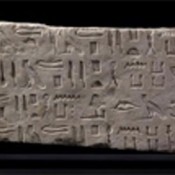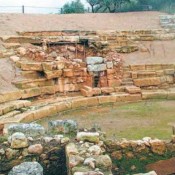A new interpretation of a stone building found at Priors Hall, Corby, is published in the latest edition of Current Archaeology magazine.
Between summer 2019 and spring 2020, OA East excavated a previously unknown late Roman industrial site. There was evidence for re-use of a stone building associated with an earlier phase of the villa, which appears to have been an enigmatic religious building.
Constructed of local limestone, the building consisted of a well-built single celled square building set within a rectangular courtyard, bounded by stone walls that formed a square precinct. This follows the basic plan of Romano-Celtic temples apart from its orientation facing west, as opposed to the common east facing orientation. It seems likely that the excavated building at Priors Hall was a mausoleum (or temple-mausoleum).
The central cella would have been topped with a limestone tiled roof. Standing at a considerable height, it would have stood proud in the local landscape, an impressive commemoration to the memory of its financier. The Romans tended to call these funerary monuments ‘monumentum’ and they were physical embodiments of the need to perpetuate the memory of the elites who built them, rather than meeting the spiritual needs of a local population.
Based on trends in the construction of such monuments and given the relationship to its villa neighbour, it is probable that the Priors Hall mausoleum dates to the late 2nd to 3rd century: radiocarbon dates are awaited. The temple-mausoleum appears to have fronted directly westwards onto a road or track which was represented by two parallel drainage ditches that ran north-west to south-east.
At some point in the later 3rd to early 4th century, the temple-mausoleum had become dilapidated and was repurposed as tilery in an area of industrial activity, populated by dozens of workers and animals. Two kilns were constructed, the larger of which utilised the shell of the former cella.
The reuse of sacred or funerary architecture is not altogether uncommon during this period. Not surprisingly, the later reuse of the building and its precinct had removed any architectural embellishment, such as painted wall plaster, that related to its life as an ancestral monument. No human remains or artefacts associated with its function were recovered but this is not wholly uncommon. A small set of notches along the southern and northern faces of its interior cella walls may hint at its former life, perhaps as suspension attachments for ossuary cubicles, or as beam slots for a suspended floor.
Mausolea are a rare architectural phenomenon, but the dramatic change in function observed at Priors Hall, from a funerary monument to a tilery, makes this is an extremely rare find. Post-excavation work is underway and more information is coming to light as we analyse the findings.
The works took place within a wider scheme of archaeological investigation ahead of development at Priors Hall Park, a mixed-use urban extension to Corby which includes 5,000 new homes being built by Urban&Civic plc, but the previous phases of archaeological work did not identify the full significance of this area. The site of the adjacent villa has been designated and, as a significant heritage asset, will be left in-situ and will be left as a green space that will help to facilitate a shared sense of identity for the new community.Finds and records from the excavation will eventually be deposited with the brand new Northamptonshire Archaeological Resource Centre at Chester Farm Heritage Park, Irchester which is due to open in 2021.
The full article can be read in the latest issue of Current Archaeology magazine: https://www.archaeology.co.uk/articles/features/building-a-roman-villa.htm





